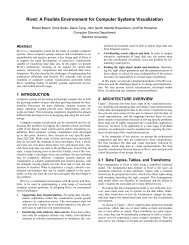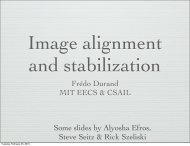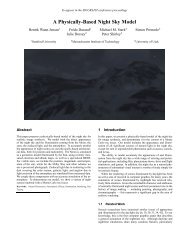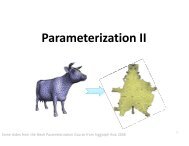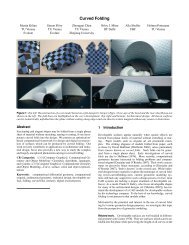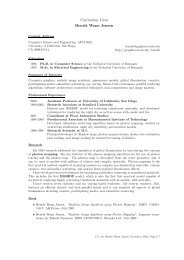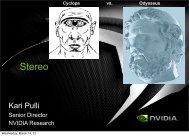A Survey of Color for Computer Graphics
A Survey of Color for Computer Graphics
A Survey of Color for Computer Graphics
You also want an ePaper? Increase the reach of your titles
YUMPU automatically turns print PDFs into web optimized ePapers that Google loves.
A <strong>Survey</strong> <strong>of</strong> <strong>Color</strong> <strong>for</strong> <strong>Computer</strong> <strong>Graphics</strong> SIGGRAPH 2001<br />
plest <strong>for</strong>m <strong>of</strong> this effect. In nature, however, interactions between lights and objects is<br />
more complex. Shiny surfaces have highlights, rough ones appear textured. Particles and<br />
layers as small as the wavelength <strong>of</strong> light produce shimmering interference effects, like a<br />
butterfly wing. Light shining through clouds <strong>of</strong> small particles produce the blue-gray <strong>of</strong><br />
smoke, the colors in the sky, and the blue in a child’s eyes. It is the goal <strong>of</strong> rendering research<br />
to produce effective models <strong>of</strong> these processes that can be used to make<br />
compelling and beautiful images and animations.<br />
Unlike image reproduction, where the focus is on producing images <strong>of</strong> objects in the<br />
world, computer graphics is focused on producing images <strong>of</strong> objects that occur only as<br />
the result <strong>of</strong> numerical models. That is, there are virtual objects, and virtual lights that<br />
must be rendered to produce a visible image. How they are modeled and rendered defines<br />
their appearance. One <strong>of</strong> the most widely referenced books on color in computer graphics<br />
is Roy Hall’s <strong>Color</strong> and Illumination in <strong>Computer</strong> <strong>Graphics</strong> Systems. Un<strong>for</strong>tunately, this<br />
book is out-<strong>of</strong>-print. However, most books on rendering include a discussion <strong>of</strong> color. I<br />
have used Andrew Glassner’s Principles <strong>of</strong> Digital Image Synthesis as my reference <strong>for</strong><br />
rendering.<br />
Simulation vs. Design<br />
Philosophically, computer graphics rendering can be organized between two extreme positions<br />
that I call simulation and design. The goal <strong>of</strong> simulation is to model reality. The<br />
emphasis is on physically correct representations and rendering algorithms, which <strong>for</strong><br />
color means at minimum a spectral model <strong>of</strong> light and surface reflectance. The goal <strong>of</strong><br />
design, on the other hand, is to produce a visual effect. Most design systems have lots <strong>of</strong><br />
knobs, and the designer may do unreal things to create the desired result. One <strong>of</strong> my favorite<br />
stories demonstrating this involves an early graphics system that could not produce<br />
shadows. Yet the designers were making pictures with shadows in them. How did they do<br />
it? They added negative lights. Because the emphasis in design systems is interaction and<br />
flexibility, they typically use computationally efficient, RGB-based models.<br />
In simulation systems, the result should be good enough to measure. Rendering involves<br />
computing the interaction <strong>of</strong> light with a material surface. Both the surfaces and the lights<br />
should be physically accurate, preferably created by measurement. The equations that<br />
control the interaction and scattering <strong>of</strong> the light should also be physically accurate. Radiosity,<br />
and more broadly, global illumination models, are required to describe the<br />
interaction <strong>of</strong> light throughout the scene. To define the visual representation <strong>of</strong> the image,<br />
tristimulus theory at a minimum is used, with more advanced perceptual models a topic<br />
<strong>of</strong> current research.<br />
In design systems, what the final image looks like is the goal. Unreal may be good, as in<br />
the negative lights example above. Designers don’t object to using physically accurate<br />
models, as long as they are efficient and flexible. Because per<strong>for</strong>mance is a paramount<br />
concern, simple lighting and shading models that can be accelerated with special hardware<br />
are the most common in design systems. Most <strong>of</strong> these have their basis in Phong’s<br />
original shading model, which is extended to color simply by applying it to RGB independently.<br />
Paul Strauss created an extension <strong>of</strong> this that has become part <strong>of</strong> SGI’s Open<br />
Inventor (www.sgi.com), which is a widely-used 3D graphics <strong>for</strong>mat. The designer can<br />
either simply paint surfaces or vertices with RGB colors, or apply simple material and<br />
Maureen C. Stone 16<br />
StoneSoup Consulting




